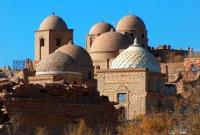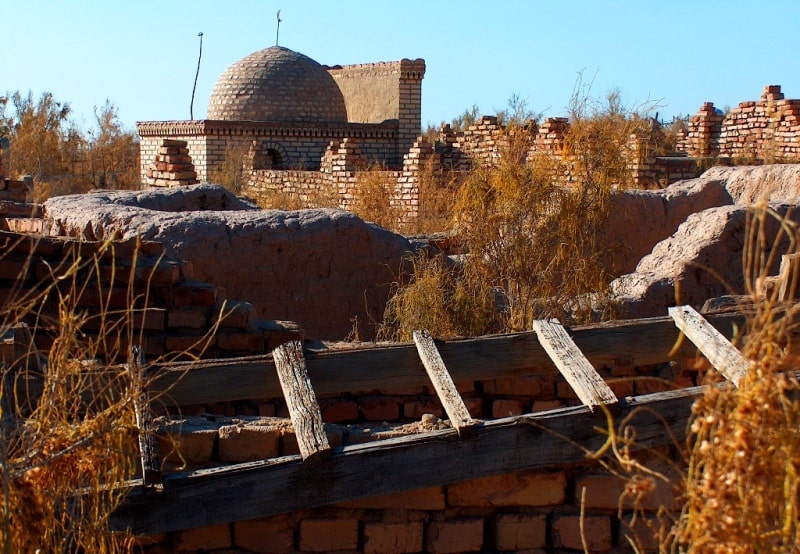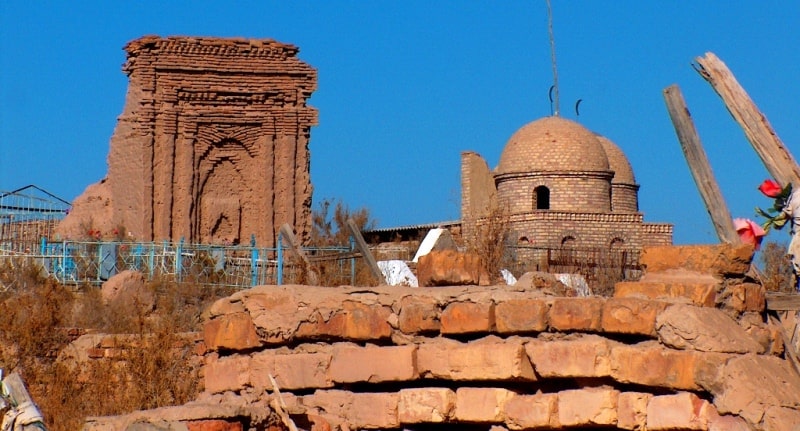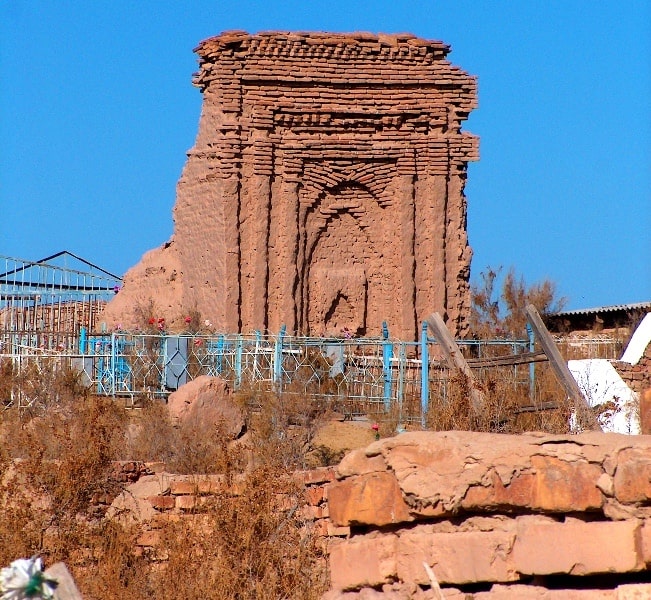Вы здесь
Necropolis of Mizdahkan.

Tours to Mizdahkan necropolis.
“People usually feel funny, smile and laugh when I tell them
about my strong belief in the very existence of prehistoric
advanced technology and great civilizations of wilier races.
I just can't wait to see their faces at time the truth is revealed”
Toba Beta.
Trip from Nukus to Mizdakhan necropolis.
The necropolis of Mizdahkan is located on a natural hill 104.6 meters above sea level, 4.4 kilometers west and slightly south of the city of Khojeyli, 1.4 kilometers northeast of the Gyaur kala (Khojeli) settlement in the Khojeli region of the Republic Karakalpakstan.
The ancient archaeological complex of Mizdahkan is located on a significant area - more than 200 hectares. After drawing the monument on the maps, Academician V.V. Bartold localized on it the ancient city of Mizdahkan with the eponymous rustak.
In 1928 - 1929 the monument was examined by A.Yu. Yakubovsky. In 1946, he underwent a new survey by the Khorezm archaeological and ethnographic expedition of the USSR Academy of Sciences. In 1962, 1964 - 1965, the monument was studied by a stationary archaeological expeditionary team of the Institute of History, Language and Literature of the Karakalpak branch of the Academy of Sciences of the Uzbek SSR.
In 1964 and 1966, a special planned aerial photography of the entire complex of the ancient Mizdahkan was made. The works on the architectural monuments of the complex were carried out by A.Yu. Yakubovsky, V.I. Pilyavsky, V.M. Filimonov.
A.Yu. Yakubovsky in 1928-1929 described such architectural monuments of Mizdahkan as the mausoleum of Mazlumkhan slu, the unnamed mausoleum of Khalifa-Erezhep. In 1947, the architectural objects of Mizdahkan were examined by V.I. Pilyavsky.
In 1959 and 1966, in connection with the development of the Mazlumkhan restoration project, the architect V.M. Filimonov was studying it.
The complex of antiquities of Mizdahkan includes:
1. The ancient settlement of Gyaur kala.
2. Monument to Khalifa Erezhep.
3. Mausoleum of Mazlumkhan Slu.
4. Mausoleum of Shamun nabi.
5. Ruins of the town of the Golden Horde period on Mizdakhana.
6. Suburban and urban irrigation network and field layouts on Mizdakhana.
7. Town cemetery, which was also used by the population of the nearby district (rustaka Mizdahkan).
The entire complex of antiquities is located on three heights and in a significant space between them. The ruins of the city are located on the western hill and also in the plain to the west of the hills. The western hill is completely occupied by an ancient necropolis used for burials of the present time.
The ancient necropolis has been in use since at least the beginning of our era. The oldest part of it is an ossuary burial ground, it is overlapped by an early Muslim necropolis. The ossuary burial ground occupies the entire western half of the hill.
The oldest part of the Muslim necropolis is also located here. Burials of the 16th - 19th centuries concentrated mainly on the flat top of the hill, and the modern cemetery gravitates towards its eastern part. During the excavations, ossuaries were found with paintings, inscriptions in the ancient Khorezm language with various religious symbols.
A single rich ceramics burial from the half of the 8th century AD was discovered.
Divided into a number of types on Mizdakhana.
Type I - burials in rectangular ground pits - XIII - XIV centuries.
Type II - burials in brick crypts with a gable roof - XIII - XIV centuries
Type III - burials in brick crypts with flat roofs - XIII - XIV centuries.
Type IV - burials in brick crypts covered with flat-convex adobe blocks – XI - XII centuries.
Type V - burials in slit burial chambers covered with square mud bricks - second half of the VIIIth - X0th centuries. AD
Type VI - burials in slit-like burial chambers covered with adobe rectangular bricks - second half of the VIIIth - Xth centuries AD
Type VII - burials in slit burial chambers covered with rectangular mud blocks, one of which is set obliquely - the second half of the VIIth - Xth centuries. AD
The necropolis contains a number of architectural monuments, the mausoleums of Mazlumkhan slu, Khalifa Erezhep, Shamun nabi and the Jumart kassab hillock. On the slopes of a placer of pottery fragments of the XIIth - XIVth centuries. it is believed that the remains of an ancient building are hidden under the hillock.
On the flat top of the hill, there are also numerous burial buildings of the XVIIIth - XIIXth centuries. At the southern edge of the northern part of the hill, on an area of approximately 125 x 75 m, there is a whole system of low flat mounds, strewn with fragments of Khorezm ceramics of the XIIth - XIVth centuries, hiding in their depths some large multi-room building or a complex of buildings.
Geographic coordinates of the Mizdakhan necropolis: N42 ° 24'07.31 "E59 ° 23'26.16"





Authority:
Oktyabr Dospanov, archaeologist, candidate of historical sciences.
Literature:
1. Grazhdankina NS "Building materials for the mausoleums of Mizdahkan". Architectural heritage of Uzbekistan, Tashkent, 1960.
2. Esbergenov H.E., Yagodin V.N. "Some results of the study of Mazara Shamun-nabi." VKK FAN UzSSR, No. 4, 1966.
3. Nekrasov A.A. "Inscriptions on the gravestones of the Mazlumkhan-Slu mausoleum in Mizdahkan." ZKV, vol. U, L. 1930.
4. Pilyavsky V.I. Urgench, "Mizdahkan". M. 1948.
5. Filimonov V.M. "Mazlum-Slu Palace, a unique monument of civil architecture." In the collection: Materials and research on the history and restoration of architectural monuments in Uzbekistan. Issue 1,
ashkent, 1967.
6. Yagodin V.N. "New data on the history of the religion of Khorezm." SE, No. 4, 1963.
7. Yagodin V.N. "To the study of the chronology and topography of the ancient Mizdahkan." In the collection “History, archeology and ethnography of Central Asia”. M. 1968.
8. Yagodin V.N., Khodzhayov T.K. "The necropolis of the ancient Mizdahkan". Tashkent, 1970.
9. Yakubovsky A.Yu. "Mizdahkan Settlement". EKV, vol. U, L. 1930.
Photos by
Alexander Petrov.







